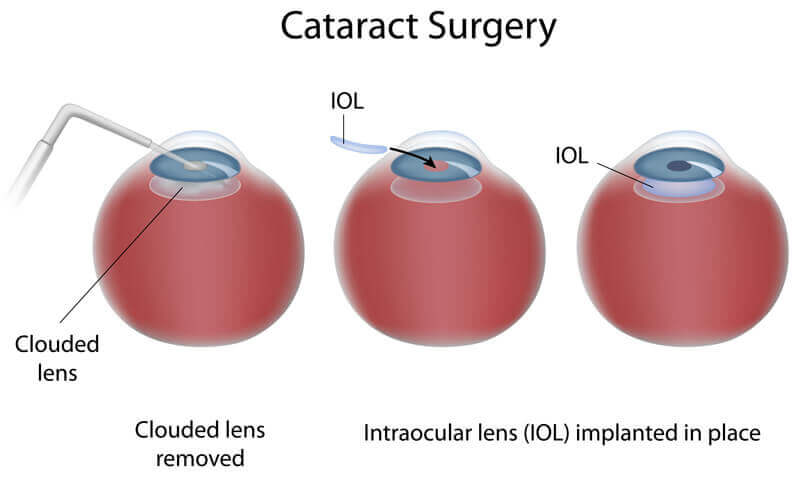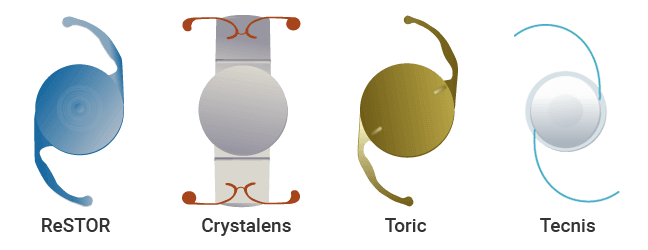What is a Cataract?

A cataract is a clouding on your eye’s natural lens. Degenerative changes in your eye’s structure cause lens proteins to precipitate and clump within the lens of your eye, producing opacities, and clouding vision.
Typically, the degenerative eye changes are a natural occurrence during your aging process. Your cataract will cause blurred vision because the crystalline lens of your eye needs to remain clear to properly focus images on your retina. However, eye injuries, diseases, and some medications can also contribute to the formation of cataracts.
Our eye doctors have treated cataracts in San Antonio for many years. Our experience and use of state-of-the-art-technology make us a clear choice for cataract surgery. Worried about cataract surgery cost? Ask about our many options for financing your procedure.
Cataract surgery is the most commonly performed procedure in the United States. You should choose an eye surgeon carefully – taking into account such factors as the doctor’s training, past success, and confidence he or she instills in you – no one should hesitate to have this procedure. Life is too good to miss because of clouded vision!
Learn more about our specialties in cataract treatment in Texas MD’s featured article of Dr. Lisa Martén Clarity and Cataracts.
What are Possible Symptoms of a Cataract?
- Blurred, cloudy, or distorted vision
- Double vision
- Inability to see bright colors at their full intensity
- Progressive loss of vision/frequent need to update vision correction prescription
- Poor night vision
- Increased sensitivity to glare
- Appearance of halos around lights
- Visible white spot on pupil
The above symptoms are not exclusive to cataracts. If you are experiencing any of the above signs, with our doctors today.
Call us at (210) 692-1388 or schedule a vision assessment with one of our skill cataract specialists to explore vision correction options, and the potential early detection of other serious health problems.
How Fast Can Cataracts Develop?
Cataracts develop in stages but do not necessarily progress at the same rate. As the cataract increases in size, its symptoms also tend to worsen.
Some cataracts may quickly develop over a few months, while others may take years to mature. In some cases, cataracts never grow out of the early stages and present little or no vision problems.
Cataracts in later stages, however, can make day-to-day living difficult. Although you may eventually develop cataracts in both eyes, having a cataract in one eye does not lead to getting a cataract in the other eye.
Am I a candidate for Cataract Surgery?
As a potential candidate for cataract surgery, you may benefit from our latest procedure options. Fill out the self-test survey to determine if you’re a good candidate for laser cataract surgery!
Good Candidates
Minimal Astigmatism
Healthy Eyes Except for Cataracts
Desire to Reduce Dependency on Glasses
Poor Candidates
Large Amount of Astigmatism
Advanced Glaucoma
Macular Degeneration
Other Significant Ocular Diseases
Excessive Night Driving
Laser Cataract Surgery
Cataract surgery involves the removal of the clouded lens and substitute of a clear, synthetic one. The lens is broken up with an ultrasonic probe and suctioned out through a microscopic incision. Once the old lens has been removed, a synthetic intraocular lens is inserted. A variety of IOL implants may be used depending on the patient and the circumstances of the procedure.

LENSAR® Technology
We now offer laser-assisted cataract surgery to improve precision and safety during your procedure. The femtosecond technology coupled with incision planning, corneal marking, and integration of pre-op data allows for top-notch results in laser-assisted cataract removal.
Watch this video about the amazing benefits of laser-assisted cataract surgery versus surgery under the blade.
ORA Technology
We can use the new ORA system to better predict results and decrease the margin of error in lens selection. ORA is an intraoperative aberrometer that uses surgeon optimized software for the most accurate lens selection in patients with high astigmatism, post-LASIK patients, or those with very dense cataracts. Real-time capture of measurements after cataract removal improves accuracy and maximizes the lens power selection.
At South Texas Eye Institute in San Antonio, cataract surgery has benefited countless patients whose vision was fading, many who were nearly blind. If you live in the San Antonio, Texas area and would like further information about cataract surgery, contact South Texas Eye Institute today!
Before Cataract Surgery
Dr. Lisa Martén can reintroduce you to a world of clear vision through advanced cataract surgery. At a state of the art surgery center, Dr. Martén offers LensAR Laser Cataract Surgery, ORA technology, and a wide array of lens implants with two fully equipped ORs and excellent support staff.
When Should I Have Cataract Surgery?
Being diagnosed with a cataract does not mean that you must have cataract surgery. If your vision loss from a cataract is not interfering with your life or can be easily remedied with an updated eyeglass prescription, you do not need to undergo cataract surgery.
Once the cataract is affecting your vision to the point where it is interfering your daily living, you should discuss your eye care options with our San Antonio eye surgeon, Dr. Lisa Martén. Delaying cataract surgery will not make the surgery more difficult to perform or cause any long-term ill effects to your vision.
Be sure to ask any questions you may have and to express any concerns to your surgeon, so you can make an informed decision about when to have cataract surgery. Contact us at (210) 692-1388 or send us a message to learn more about your eye care options.
The Day of Cataract Surgery
How is Cataract Surgery Performed?
Cataract surgery is one of the most common vision correction operations in the United States. Advancements in technology allow cataract removal to be performed as an outpatient procedure using local anesthesia.
Laser cataract surgery prepares the eye for surgery by creating the incisions reducing pre-existing astigmatism and breaking up the lens into smaller pieces. During the cataract removal procedure, the surgeon will remove the eye’s natural lens using a process called phacoemulsification, or phaco. Through a small corneal incision, a small device uses ultrasound waves to break up and remove the lens. An intraocular lens (IOL) is then inserted through the incision to replace the natural lens.
Selecting Your Lens Implant Type
Once you have made the decision with your doctor to undergo cataract surgery, you will have a series of choices to make. These relate to the type of lens implant that will best fit your lifestyle.
Monofocal lenses allow clear vision at one distance only if do not have astigmatism. You may need glasses either to correct astigmatism or to correct for vision at different distances.

You and your eye doctor will work together to determine the right lens for your eyes. If an advanced/premium lens implant is suitable, and the chances of success are good, you can explore this path.
Advanced lenses typically come with an extra cost that Medicare and most insurances do not cover. Advanced lenses allow a wider range of vision from reading to distance without always having to put on glasses.
With advanced lenses, you can enjoy eyeglasses-free vision for about 80-90% of the time.
No lens is as perfect as your natural lens, and they all have pros and cons. We will be able to guide you in choosing your best lens.
- Multifocal
- Accommodating
- Toric
- Combination
Multifocal Lens Implants are advanced lenses with multiple focal points, designed to replace cataracts and correct presbyopia. These lenses split light to provide clearer vision at different distances. Multifocal IOLs provide an improved range of vision for near, intermediate, and distance vision.
IOL: Multifocal Lens – Overview
Accommodating Lens Implants are advanced/premium lenses that contain hinges that allow for flexibility of the lens. The hinge helps mimic the natural lens by moving inside the eye to accommodate.
These lenses can provide improved near, intermediate, and far vision. The Crystalens and the Trulign™ -Toric Accommodating Intraocular Lenses (Bausch & Lomb) currently are the only FDA approved intraocular lenses (IOL) that use a method called accommodation.
IOL: Accommodative Lens – Overview
Toric Lens Implants are lenses that can correct astigmatism. This lens has a single focal point designed to correct preexisting astigmatism.
Mild to moderate astigmatism can be corrected to improve distance vision without dependence on glasses. Glasses will be required for near vision activities such as reading.
Combination Multifocal / Toric Implants– are available as an option for patients who have mild to moderate astigmatism but also want to improve the range of vision up close.
Combination Accommodative / Toric Implants- Trulign™ can correct for low to moderate astigmatism and has the same accommodation properties as the Crystalens.

